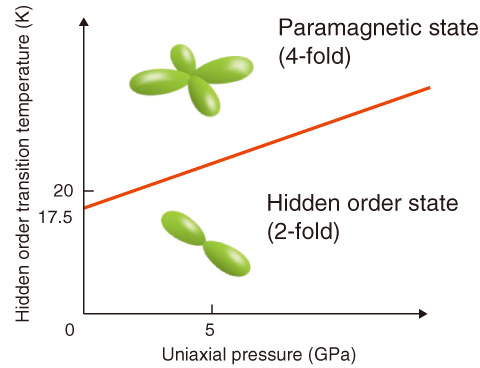
Fig.7-7 Uniaxial pressure cell

Fig.7-8 Uniaxial pressure dependence of hidden order transition temperature (![]() line)
line)
In the superconducting state, two electrons form a superconducting pair. An attractive interaction between the electrons is necessary for the formation of paired electrons. In conventional superconductors, the attractive interaction originates in lattice vibration. In contrast, magnetic fluctuation is considered to be the origin in actinide superconducting compounds. Because a high superconducting transition temperature Tc can be expected for a magnetic-fluctuation-induced superconductor, it is important to clarify the mechanism for the fluctuation.
In URu2Si2, the so-called hidden order state appears below 17.5 K (-256 °C). Because the superconducting state appears at a lower temperature of 2 K (-271 °C), magnetic fluctuation in the hidden order state is considered to induce superconductivity. However, the hidden order was not identified for 25 years, which is an important issue in condensed matter physics.
This compound has four-fold symmetry in the paramagnetic state above 17.5 K. Recently, however, it was revealed that the electronic state exhibits symmetry breaking from the four-fold to the two-fold state with hidden order. In this study, the hidden order is investigated in a two-fold lattice state artificially induced by uniaxial pressure. To apply uniaxial pressure at low temperatures, we developed a uniaxial pressure cell (Fig.7-7). As shown in Fig.7-8, the hidden order transition temperature increases under uniaxial pressure, indicating that electrons and the lattice are coupled, and we can manipulate the magnetic fluctuation that induces superconductivity. This technique is expected to yield an understanding of magnetic fluctuation and to facilitate the development of high-temperature superconducting materials.
A future new superconductor with a higher Tc is expected to be realized in a magnetic-fluctuation-mediated superconducting system, because the Tc value of phonon-mediated superconductors has already reached its peak. If a new superconductor with a room temperature Tc is found, it will be quite useful for improving the energy efficiency.
We are going to investigate actinide compounds to clarify the mechanism of superconductivity in detail.